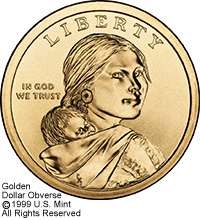2009 Native American $1 Coin


The 2009 Native American $1 Coin is based on the theme of agriculture. Its reverse features a Native American woman planting seeds in a field of corn, beans and squash and the inscriptions UNITED STATES OF AMERICA and $1.
Spread of Three Sisters Agriculture (1000 A.D.)
Maize was domesticated in central Mexico and spread from the southwest through North America, along with symbiotic "Three Sisters" agriculture, in which corn, beans and squash growing in the same mound enhanced the productivity of each plant.
Native American skill in agriculture provided the margin of survival for the early European colonists, either through trade or direct sharing of expertise, and agricultural products native to the Americas quickly became staples throughout Europe.
Three Sisters symbiotic agriculture—planting corn, climbing beans and squash together in the same plot—also originated in central Mexico and probably spread simultaneously with the corn. In this efficient planting method, corn stalks provided support for the bean vines, which added nitrogen to the soil. Squash provided ground cover, which discouraged weeds. Productivity was much higher (by some estimates as much as 30 percent) for the three grown together than each grown separately.
Background: Agriculture
Agriculture has always been an important subject in Native American culture.
Native American culture emphasizes living with the land and understanding the surrounding natural resources.
When Europeans first arrived in the "New World," one of the largest contributions and benefits of their relationships with Native Americans was the sharing of agricultural information.
It is widely acknowledged that colonists would not have survived in the New World without the support and knowledge gained from Native American agricultural techniques.
Native Americans practiced crop rotation, round cropping, hybridizations, seed development, irrigation methods and many other agricultural techniques that are still used today.

